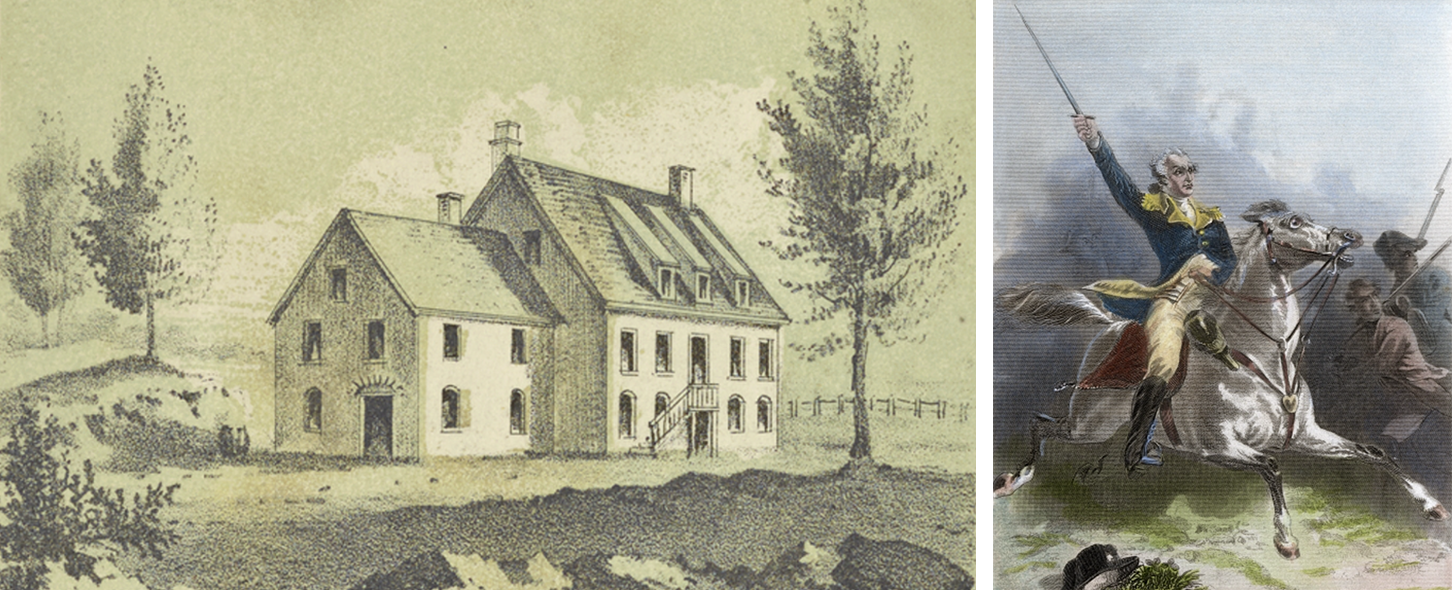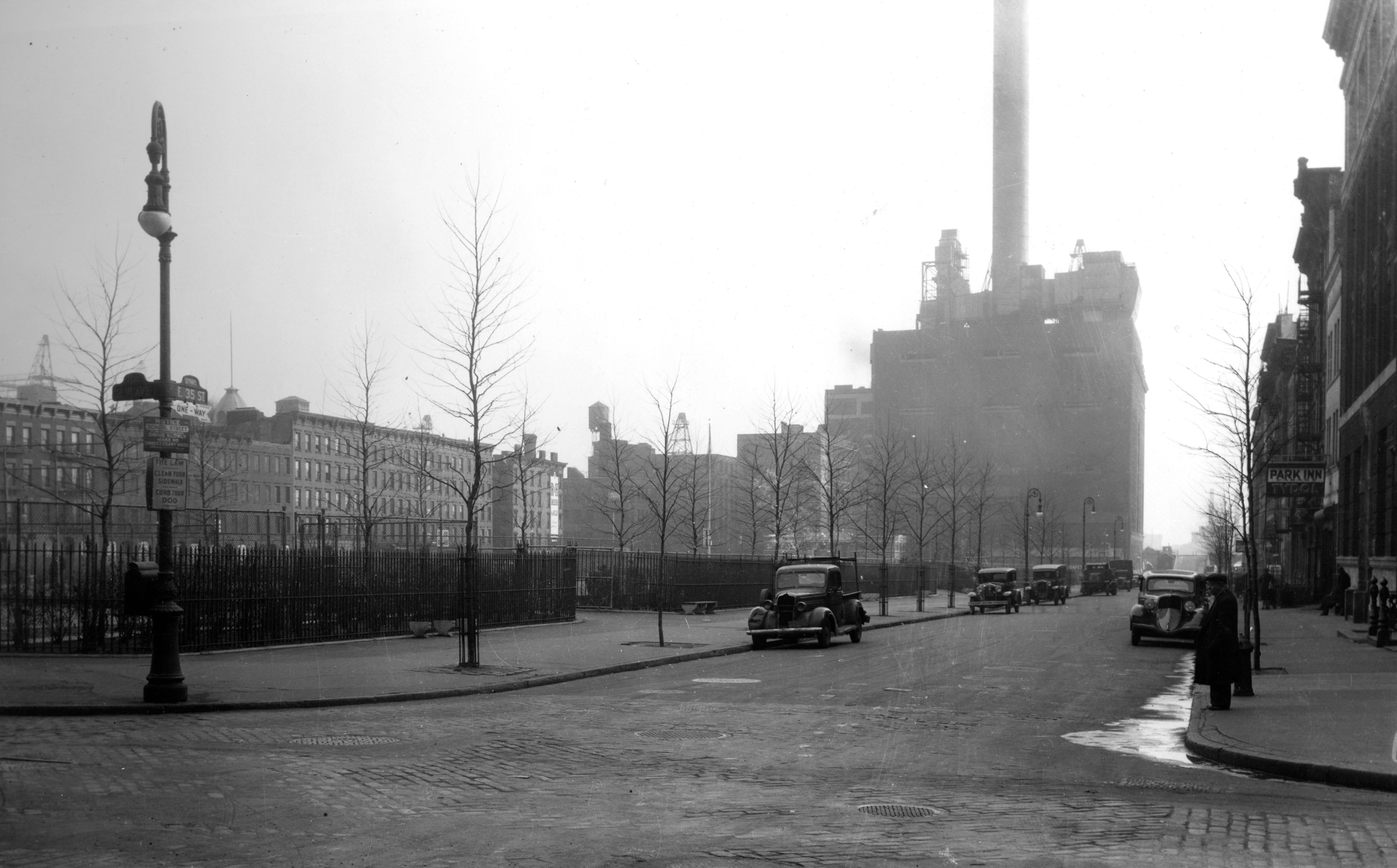History
Originally known as Civic Park and St. Gabriel’s Park, the park was renamed in May 1978 in recognition of the adjacent St. Vartan Armenian Cathedral on Second Avenue and East 35th Street.
The park was contiguous until the construction of the Tunnel Approach Street for the 1940 Queens-Midtown Tunnel cut the park in two. As a result, the shape of the park resembles an exclamation point.
A journey through the park’s history is presented through images and publication excerpts on this page and this site’s About, Events, Garden, Playground, Field, Basketball, Handball, Pickleball, Permits, Building, Wildlife, Swish and Posts pages.
Retrospection
“Early topographic maps suggest that there is one location . . . that would have had characteristics attractive to Native Americans, at Second Avenue and 42nd Street . . . a well-drained area north of a stream that crossed Second Avenue at 37th Street and that emptied into the East River less than one block away. The [Second Avenue and 35th Street] area at St. Vartan Park was once located between two streams that emptied into Kips Bay on the East River. The area would have had a riverine and an estuarine environment, making it suitable for hunting, fishing and, just east . . . collecting of shellfish. It also may have contained discrete sections of habitable land.”
“. . . treading on historic topography . . . In 1665, Jacob Kip finished his home on a site between 35th and 36th Streets just east of Second . . . was destroyed in 1850 [when it was the oldest house in Manhattan] . . . Kips Bay itself extended inland to mid-block between First and Second Avenues. In September 1776 [from] the bay, 4,000 British and Hessian soldiers invaded Manhattan and routed the green Connecticut troops, who fled west. General George Washington failed to rally his army . . . and the Americans retreated . . . The British held Manhattan for the next seven years. ”
“Not only was General George Washington entertained in the [Kip] house, he used it briefly as his headquarters during the Revolution . . . Washington returned at least once and received an impressive gift, at least for the time. Sometime shortly after Washington’s [1789] inauguration . . .’now invested with Presidential honors, made an excursion, and was presented with the rosa gallica, an exotic first introduced into this country in this garden—fit emblem of that memorable union of France and the American colonies in the cause of republican freedom.’”
“A contract for this park has been let, the design including permanent playground features. This park is small in area, covering but one city square, but the plans have been designed to make the best possible use of every available inch of space.”
“Work on this improvement . . . consisted of the general excavation of rubbish, bricks, walls . . . and all foreign materials, and placing fresh, clean, wholesome earth filling in enhancement and slopes . . . 8,000 cubic yards of excavation of all kinds removed, 3,000 cubic yards of filling furnished in place.”
“The park . . . takes in the square between Thirty-fifth and Thirty-sixth Streets, and First and Second Avenues, formerly a crowded tenement block. The work of demolition of the old tenement structures was begun February 3, 1904, and the improvement has hastened in every possible way . . . The destruction of the tenements has left the site covered with rubbish and debris to a depth of seven feet, but the work of removal will be completed in a few months. ”
“. . . it was natural to begin at once to try and secure for the new neighborhood a park. . . We began by getting the use of two adjoining lots as a playground which we called the Kips’ Bay Playground. The interest of St. Gabriel’s Parish in this matter was great. That large parish, whose pastor was later Cardinal Farley, had the interests of its children close to its heart. Cooperating with them, St. Gabriel’s Park finally came into existence as the flowering of the Kips’ Bay Playground.”
“The Park Board last September announced the name of the park as Civic Park.”
“A number of residents in the neighborhood of Civic Park . . . have begun a fight against the proposition of William J. Boyhan, the Tammany Alderman of the district, to change the name of the park to St. Gabriel’s. The credit for getting the park in the district, it is asserted, belongs to the Civic Club, which has its home in the neighborhood. The protest against the change is made in the name of a number of Catholics, who declare that the change would be an injustice to the Civic Club . . . A public hearing has been asked for on the resolution, but it is likely that the request will be discharged.”
“St. Gabriel’s Park opened. Paved throughout with not a tree or blade of grass in sight, it was the first of many play spaces built exclusively for team-based sports and exercise classes.”
“[Joseph Thomas] is the only voter in the Nineteenth Election District . . . he is receiving more consideration, from an official point of view, than any other voter in the United States . . . The conditions which made Thomas the monarch of all he surveys from a voting point of view was created by tearing down nearly all the residences in the election district to make room for St. Gabriel’s Park.”
“Although several members of St. Gabriel’s Catholic Church near by had opposed the name of Civic Park . . . to ‘St. Gabriel’s Park,’ the aldermen made the change yesterday. ”
“. . . one of the little-known parks on Manhattan Island will become better known to New York City residents . . . Four years ago or so, houses facing and adjacent to the park were sold from $12,000 to $15,000. They now command $50,000 . . . Factors that are calling marked attention to this property are the great commercial expansion in the Grand Central zone eastward, through the Forty-second Street area across Lexington and Third Avenues, and the assured activity in the easterly Thirty-fourth Street centre at no distant date. ”
“. . . directors of the First Avenue Association . . . explained that the proposed Thirty-fifth and Thirty-sixth Street [tunnel] entrance and exit plazas would directly adjoin St. Gabriel’s Park, which is between First and Second Avenues. The park, the committee pointed out, is one of the few breathing spaces in this congested section of the East Side. Its usefulness for park purposes would be at an end, the committee asserted, if streams of vehicles were constantly passing its borders on their way to and from the tunnel. Not only would the traffic prevent safe and easy access to the park, the report said, but the motor exhaust fumes would be an added objection. The committee’s proposal for use of the Thirty-seventh and Thirty-ninth Streets would leave the park undamaged . . .”
“St. Gabriel’s Park, on First Avenue, opposite the steam plant, is one of the few recreational areas in the neighborhood.”
“Charging that the Queens Midtown Tunnel Authority had ‘carefully and deliberately neglected to tell me’ of its plan to use part of St. Gabriel’s Park on the East Side as an approach plaza for the tunnel, Park Commissioner Robert Moses angrily warned the authority yesterday that under no circumstances would he permit such use of the park . . . assailing the authority for ‘cold-bloodedly’ attempting to take the park, which occupies the block . . .”
“Drafters of the New York City Tunnel Authority bill have stolen a march on Park Commissioner Robert Moses, it developed today . . . he can’t do anything about it . . . The bill passed [the New York] Legislature Tuesday, which authorizes construction . . .”
“Remember that little patch of green between 35th and 36th Streets and First and Second Avenues in Manhattan? St. Gabriel’s Park, wasn’t it? That was the name yesterday. Now, however, it’s St. Vartan’s Park, to reflect the towering presence of St. Vartan’s Armenian National Cathedral on the opposite side of Second Avenue.”
“Young professionals and families are flocking to Murray Hill . . . St. Vartan Park spans the area from East 35th to East 36th Streets and from First to Second Avenues . . . it is the largest park in Murray Hill, with baseball and football fields, as well as basketball and handball courts . . . Fred Arcaro, 75, a retired electrical engineer and president of the Manhattan East Community Association, has lived near First Avenue since 1989. He is hopeful that the growth will include more green spaces . . .”
“Four small neighborhood parks , to be incorporated in the project of Borough President Miller for an East River drive, are urged by the municipal affairs committee of the New York League of Women Voters in a letter to Mr. Miller . . . one to each mile of the drive . . . the fourth being made by extending St. Gabriel’s Park. Such a plan would provide, the letter points out,. ‘a few breathing spaces in one of the most densely populated areas in the world.’ ‘We realize that the acquisition of even small park areas,’ the letter continues, ‘will add to the cost of the East River drive, but we believe and we know that you will agree that the children of Manhattan are worthy of at least as much consideration as its automobiles . . . The East River drive makes possible an extension of this program to the part of the city which needs it most.’”
“On a chilly evening earlier this month, hundreds of protesters gathered in St. Vartan Park in Manhattan’s Kips Bay neighborhood . . . It was crowded enough that some people had to stand atop the play structure in the back of the park. Speakers addressed the group, urging them not to give up the fight for trans rights, and to pressure CEOS and the government to uphold protections for trans children.”
In the 1997 film ‘Men in Black,’ co-stars Tommy Lee Jones and Will Smith are portrayed riding in a speeding car (taking a right turn in right image) alongside St. Vartan Park on East 35th Street between First Avenue and Tunnel Approach Street on their way to the adjacent Queens Midtown Tunnel



























